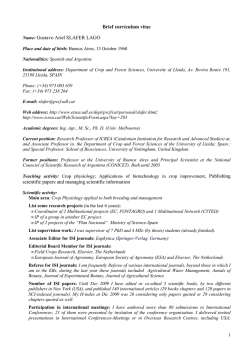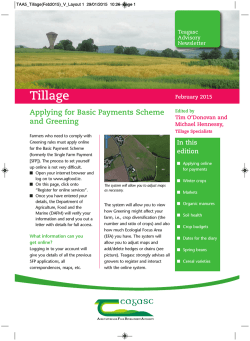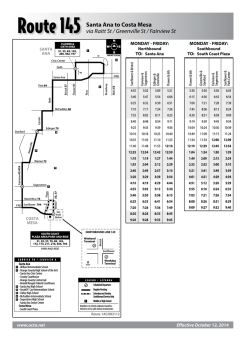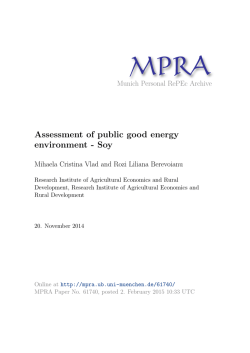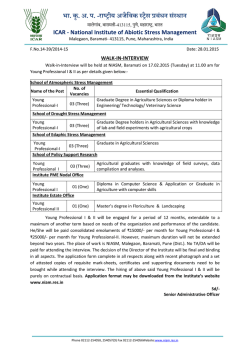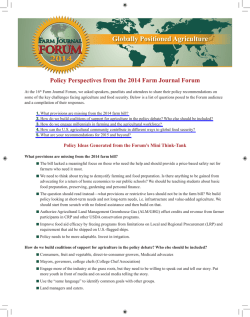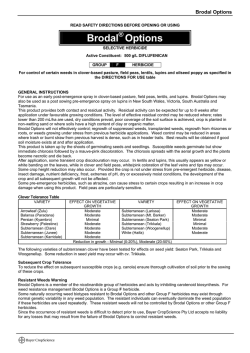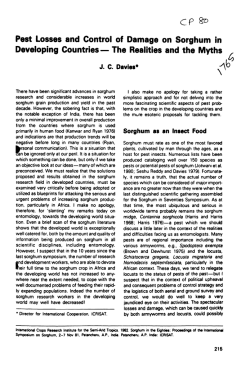
Download (344kB) - Munich Personal RePEc Archive
M PRA Munich Personal RePEc Archive Analysis of sunflower production, at macro and microeconomic level. Case study Giorgiana Rotaru and Mariana Nastase University of Agronomical Sciences and Veterinary Medicine Bucharest, Calarasi subsidiary, University of Agronomical Sciences and Veterinary Medicine Bucharest, Calarasi subsidiary 20. November 2014 Online at http://mpra.ub.uni-muenchen.de/61736/ MPRA Paper No. 61736, posted 1. February 2015 06:32 UTC ANALYSIS OF SUNFLOWER PRODUCTION, AT MACRO AND MICROECONOMIC LEVEL. CASE STUDY GEORGIANA ROTARU, MARIANA NĂSTASE1 Abstract: In this study, the production technology of sunflower crop was analyzed, by comparison, in Calarasi county and a company located in Baragan area. The technological system components were analyzed regarding the technology of sunflower crop, practiced in the farm subject to the case study, namely: crop rotation; tillage; fertilization; seed and sowing; maintenance; harvesting. These components are joined by labor force and equipment used, materials and supplies consumed, way of organization and of course, corresponding costs. Also, the study is elaborated by passing from the national plan, to the county medium plan (Calarasi county) and micro, for the studied company with reference to surfaces, production, financial and economic results. The analysis made at macro and microeconomic level highlighted the importance of compliance with the technology fiche plan and with the crop and soil requirements, in terms of materials used, with particular emphasis on varieties and hybrids recently established on the market, which bring great production increases. Key words: technology fiche, efficiency, average production, gross margin, crop technology. INTRODUCTION For the application of some modern technologies in the farms, there are framework technologies on crops, which set out the component technical works, with general parameters to execute them. The framework technologies adapt to the local specific climatic conditions in each farm. In determining technologies it is considered that the same average production can be achieved by using several technological options, convenient in terms of satisfaction of the plant requirements, but not equivalent in terms of economic efficiency; it requires the use of technology in unity and interdependence of technical and economic aspects. [5]. Regarding the technical aspect, we can say that the works and resources have been designed to create favorable conditions for the growth and development of plants and for obtaining some high productions per area unit. The economic side highlights the economic effort to allocate resources and to perform works in order to achieve higher productions on area unit, with low power consumption, minimal cost, unit cost and higher profits per hectare. [4]. MATERIAL AND METHODS The analyzed production technology in the studied companies focused on sunflower crop. All crops were mentioned successively, by: establishing the economic and plant importance, favorability areas, description of the period of vegetation, seeding, harvesting, the main varieties used, quality conditions, description of work processes by characterizing the necessary manual and mechanized labor force, agricultural machinery, materials recommended for achieving optimal quantity and quality. The study focused on the analysis of data provided by SC Ildu Ltd, Vâlcelele commune, Calarasi county, on the data of achievements of INCDA Fundulea, as well as other specific publications in the specialized literature and scientific articles in the analyzed databases [3,4]. In analyzing the production technology of the crop, the following economic and technical indicators were used: average production per hectare (kg/ha); average production for an analyzed period; income per hectare (V), (lei/ha); direct costs per hectare (Ch d) (lei/ha) as a result of direct costs 1 PhD University Assistant Georgiana ROTARU, PhD University assistant Mariana NĂSTASE, University of Agronomical Sciences and Veterinary Medicine Bucharest, Calarasi subsidiary incurred in the crop technology; Gross margin (MB = V-Ch d); coefficient of variation; confidence limits for risk; determination coefficient and correlation coefficient. RESULTS AND DISCUSSIONS The sunflower crop has a special significance in our country; therefore, the crop is spread over large areas, being appreciated in areas with difficult climatic conditions. The sunflower fruits (achene) contain a of 50%, oil with exceptional food quality and high conservation degree; they are used in human food (refined) and in the food industry (margarine, cans, soap, lecithin phosphatides, etc.) [8]. The sunflower can be placed in rotation after autumn or spring cereals. It is not recommended sowing sunflower seeds after sugar beets, alfalfa, Sudan grass, as they dry ground strong and deeply. It is not recommended also to sow sunflower after rape, peas, soybeans, beans, as these crops have many common diseases (Sclerotinia, white and grey mold, etc.). The sunflower in crop rotation should lie on the same field not earlier than 7-8 years, in order to prevent the accumulation of soil in the seed of broomrape (Orobanche) and infectious diseases. It is interesting that, by the established eco conditions compliance, the sunflower should not be grown on the same site (plot, sub-plot) for more than 2 consecutive years, because it extracts from soil large amounts of nutrients and it promotes proliferation of some weeds, pests and specific diseases [8]. We believe that the failure of this condition encourages the exhaustion of the soil, in order to achieve some short-term profits by growing large areas of sunflowers. The land preparation is done in autumn or spring by superficial work in order to keep water reserve in the soil. The seedbed is prepared in a single pass with total grower or combiner, before sowing, at a depth of 5-6 cm. The germination capacity; minimum 95%; need for seed - 3.5-5 kg/ha (for an optimal harvest density of 30-50 thousand plants/ha); 5-13 thousand seeds per kg. The age of seed: you have to take into account the water reserve in the soil, the pressure of pests and diseases, weed pressure and used variety. The optimum time of sowing is in spring when the soil at 4-6 cm seeding depth recorded a temperature of 6-7 degrees. The density is determined depending on the biological potential of the variety, quality indexes seed and plant health, sowing time, seedbed quality and pressure of diseases at increased. Early hybrids 52 000-55 000; mid early hybrids 50 000-53 000; tardy hybrids 48 00050 000; weight of 1000 grains: 50-80 g. Seed quantity per hectare: 3.5-5 kg. Seeding depth: 4-6 cm. The harvesting begins when seed moisture content is 15-16%. It is not harvested at full maturity due to large losses by shaking. The production can be obtained up to 4000 kg/ha [8]. Following the evolution of grown area (Table 1) with sunflower, an increase of 27% in 2013 compared to 2008. Table 1 The evolution of the surface, average and total productions at sunflower crop at the country level, for the period 2007-2013 2008 2009 2010 2011 2012 2013 Average (kg/ha) δ ( kg/ha) c (%) Specification UM Thousands 835.9 813.9 766.1 790.8 995.0 1064.8 877.8 81.4 9.3 ha Surface 100.0 97.4 91.6 94.6 119.0 127.4 % X X X Average production Total production Kg/ha 654 1437 1433 1597 1798 1313 1372.0 354.9 25.9 % Thousands to 100.0 219.7 219.1 244.2 274.9 200.8 X X X 546.9 1169.7 1098 1262.9 1789.3 1398.2 1210.8 363.5 30.0 100.0 213.9 200.8 230.9 327.2 255.7 % X X Source-***MADR,2014, Techincal plants, http://www.madr.ro/ro/culturi-de-camp/plante-tehnice.html [9]. X The average production per ha in the country has experienced remarkable growth, from 654 kg / ha in 2008 to 1798 kg / ha in 2012, with a variation around the average production (1372 kg / ha) of 25.9%. Calarasi county lies entirely on the plains, for which agriculture is the main economic activity, which is mainly oriented to the crop production. In Calarasi county, the main field crops are wheat, barley, maize, sunflower, canola, soybean and field vegetables [2]. During 2000-2013, the surface of grain cereals increased by 5.5% from 252,587 ha in 2000 to 266,574 ha in 2013 [1]. In the large agricultural companies crops generally prevail that have a high degree of mechanization, because of labor force shortages. The agricultural associations and family households [3], which have sufficient labor force, plants are grown which require even under advanced mechanization conditions, high consumption of labor (vegetables, sugar beet etc.). Table 2 The evolution of average sunflower crop in Calarasi county, during 2000-2013 Specification MU 2000 2005 2010 2013 Average (kg/ha) δ ( kg/ha) c (%) kg/ha 869.1 1338.1 1669.0 1909.3 1446.4 314.3 21.7 Sun flower % 100.0 154.0 192.0 219.7 X X Source:***I.N.S.,2014, Territorial Statistics, Territorial Statistics _2014.pdf Adobe Reader[1]. X In the farm SC Ildu Ltd, the sunflower crop provides a high productivity. SC ILDU Ltd- is Romanian legal person, privately owned. SC Ildu Ltd was established in 1994, privately owned company; single associate is Vasile Iliuta . The company has as main activity “Growing cereals and other crops and livestock, farm work to obtain milk. [7] The geographical position near Calarasi town ensures sale market for the products. It has access to EAFRD program to complement the technical and material and agricultural machine able of operation in terms of efficiency of agricultural land in use and at the same time allowing farm expansion, the company has made in recent years investment from its own resources, embodied in agricultural machinery of good quality [6]. Table 3 The evolution of the main indicators characterizing the technology of sunflower crops in SC Ildu Ltd, Vâlcelele comon, Calarasi county, during 2008-2013 Sunflow er Years avera ge Specification UM 200 8 200 9 201 0 201 1 201 2 201 3 standar d deviati on c (%) standar d deviatio n average interval quadratic90%( quadrat ic (kg/ha) min Max DEv (+/-) to medium t=2,13) % average production kg/ha 200 0 280 0 275 0 250 0 275 0 320 0 2667 397 14,9 162 2321 3012 691 25,9 sale price USD/to 659 712 133 7 139 7 203 5 105 0 1198 511 42,7 209 754 1643 890 74,2 income USD/ha 131 8 199 4 367 7 349 3 559 6 336 0 3240 1487 45,9 607 1946 4533 2588 79,9 Gross margin USD/ha 118 494 177 7 129 3 309 6 102 0 1300 1056 81,3 431 381 2218 1837 141,4 Source: Data from records SC Ildu Ltd, Vâlcelele comune, Călăraşi county[7] Figure 1 The evolution of sunflower production in SC Ildu Ltd, Vâlcelele comune, Calarasi county, during 2008-2013 In recent years, the income was quite similar, except for 2012, the income reached a higher threshold of 5596 kg / ha (Figure 2). The average gross margin is 1300 lei / ha, with a large deviation of 1056 lei / ha and a coefficient of variation of 81.3% (Figure 3). Fig. 2. The evolution of income per hectare of sunflower in SC Ildu Ltd Figure 3 The evolution of sunflower gross margin in SC Ildu Ltd Table 4. Sunflower hybrids grown in SC Ildu Ltd the period 2008-2013 Crop /year 2008-2009 2009-2010 2010-2011 2011-2012 2012-2013 Sun flower LA PAMPA LA PAMPA AMIGO, LA PAMPA Gt FLORINIS PR39A15 Source: Data from records SC ILDU LLC, Valcelele, Calarasi county[7]. Hybrid LA PAMPA: accented stay-green but quickly loses water at maturity; high ecological plasticity; tolerant to broomrape (Orobanche Cumana) - to G race; good resistance to Phomopsis sp. and other specific disease; MMB = 60 g; MHL = 40 kg seed oil content = 50-52%; potential production: 4.5 to 4.7 t / ha. CONCLUSIONS 1. The agricultural technologies are characterized by joining work processes with natural biological processes. It is necessary that the sequence of works and operations necessary for the completion of each technology components must be determined according to this specific. 2. Since the production technology requires a set of work processes, dependent on the nature and structure of used production resources, its optimization is not only a technical activity, but also an economic one. The two sides of production technology, technical and economic must be addressed in interdependence, because each technology component involves the allocation of resources and of expenditure. 3.To organize and lead the application of technology means ordering components to achieve their sequence according to the technical, economic, energy and green criteria. 4. In Romanian agriculture, technologies of a high area variety are needed and depending on the form of land use. 5. The vast majority of farms does not have sufficient resources for the practice of modern technologies because only existing varieties and hybrids can not become performing without proper use of other factors (fertilizer, water, etc.). 6 While strengthening the private sector in agriculture, new technological options are required that will meet the cooperation and integration on food chains organized in the conditions of functioning on the free market. The future technologies must be simple, effective, low energy, protect the environment, they must not favor food pollution. The new technologies must ensure obtaining products in large lots, unpolluted, superior quality and cheap. 7. The factors in elaborating these technologies are scientific research institutes, industries and technical means for agricultural materials, agricultural specialists, guidance bodies and orientation of agriculture. 8. The new policies and agricultural strategy will have to implement proper agricultural technologies for the soil use and protection in order to preserve the quality of natural resources, creating an ambient environment to promote healthy prosperous agriculture, a sustainable economy, an increased chance for food security of the population; 9. The case study, by characterizing the main indicators of sunflower crop has revealed the following: - Compliance with safety technology plan is of great importance in improving the production plan; - Use of high quality varieties and hybrids, adapted to environment conditions specific to the crop, leading to extra quality and quantity of production; - The use of inputs such as fertilizers, herbicides and plant protection products must be carried out as required and soil culture and their quality must be respected; - SC Ildu Ltd is specialized in the field of crops than the growing of the main cereal crops with good results for its development; - SC Ildu Ltd, presented a high stability of production, managing to have high production increases. BIBLIOGRAPHY [1] *** Romania Statistical Yearbook 2001 -2014, INS [2] ***Calarasi county-economic profile, 2013, http://cartiere.ro/129913-judetul-calarasi-profilul-economic [3] Cretu Daniela, Andrei Radu Iova- Analysis of the natural potential and of the agricultural structures in the rural area; Scientific Papers Series Management, Economic Engineering in Agriculture and Rural Development, U.S.A.M.V. Bucharest, Volume 13, Issue 3, 2013, Print ISSN 2284-7995, E-ISSN 2285-3952 [4] Cretu Daniela, Andrei Radu Iova-Technical economic optimization of field crop technologies, by econometric methods. Case study. The 13th International Symposium, Prospects for 3rd millennium agriculture, 25-27 September, 2014, Cluj Napoca, Romania [5] Crudu Georgiana- Research on technical and economic optimization of crop technology field. Case Study., PhD Thesis,USAMV Bucureşti, 2014 [6] Iova Radu Andrei, Daniela Cretu - Aspect of economic development in the rural area in Romania. Case study, South Muntenia Development Region, Scientific Papers Series “Journal of the Union of Scientists in Ruse” Angel Kanchev University of Ruse, Bulgaria, 25-26th October 2013 [7] *** Data from company records ILDU [8] ***Sunflower crop, 2012, Agriculture gazette, http://www.gazetadeagricultura.info/plante/plante-tehnice/470floarea-soarelui/351-cultura-de-floarea-soarelui.html Sunflower crop, 2012, Agriculture gazette, http://www.gazetadeagricultura.info/plante/plante-tehnice/470-floareasoarelui/351-cultura-de-floarea-soarelui.html [9] ***MADR,2014, Technical plants, http://www.madr.ro/ro/culturi-de-camp/plante-tehnice.html MARD, 2014 crops, http://www.madr.ro/ro/ field crops / plants tehnice.html
© Copyright 2025
